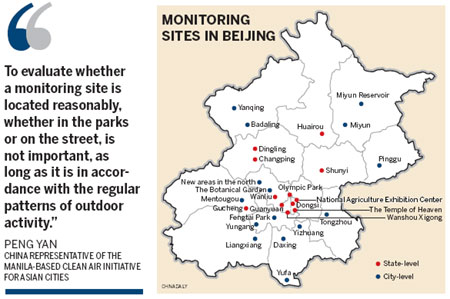Clearing the air on measuring pollution
By Peng Yining, Wu Wencong and Hu Yongqi (China Daily) Updated: 2012-06-13 08:05Getting the best out of monitoring is a priority, report Peng Yining, Wu Wencong and Hu Yongqi.
Beijing's Chegongzhuang Xilu was packed with pedestrians and cars on Monday morning, but few people even bothered to glance at the small white box set up by the roadside. However, from the telltale pumps jutting from the top, it's instantly recognizable as an air monitoring station.
Two pumps buzzed as they fed extracted air into the seven diagnostic units that assess the concentrations of nitrogen dioxide, sulfur dioxide and particulate matter in the air.
The results, displayed on a minute-by-minute basis, are forwarded to the Beijing Municipal Environmental Monitoring Center, which analyzes the data collected over each 24-hour period and publishes a daily air-quality report through TV, radio and newspapers.
Last month, China's environmental authorities ordered 74 cities to ensure that by the end of the year they have a mechanism in place to publish daily reports on levels of PM2.5, a hazardous airborne pollutant. PM2.5 refers to fine particulate matter, 2.5 microns or less in diameter. These particles are considered to pose a greater risk to health than larger airborne pollutants because they can penetrate more deeply into the lungs.
|
 |
Zeng Xiangbin, director of the Wuhan branch of Friends of Nature, an environmental NGO, recently measured the PM2.5 level in his office on a monitor bought by the organization's members. According to Zeng, the machine, which cost 25,000 yuan ($4,000), has only "two or three buttons and is very easy to operate".
The national standard for a 24-hour period is 75 micrograms per cubic meter on average, with the annual mean limit set at 35 mcg per cu m. Although he didn't expect much of the air quality in Wuhan, one of the most populous cities in China, Zeng was stunned at the result indicated by the monitor. "My result was 90. And that was in my office, the air I breathe every day," he said.
Zeng's result was called into question by Huang Yuanfeng, senior engineer at Shenzhen Environment Monitoring Center in Guangdong province.
"People certainly have the right to monitor the air quality around them, but without professional training and equipment, the results might be inaccurate and not representative of the overall air condition," he said.
However, as many of the official PM2.5 monitoring sites are located in parks, schools and nature reserves, questions have been asked about whether the data garnered accurately reflect air pollution levels. One of the major reasons that the stations, which cost 2 million yuan each, are set up in these locations is that it is easier to manage and maintain them at these locations, according to Huang.
"More important, each station covers not only the park or school, but a radius of at least 5 km," he added.
He used the monitoring station at Huaqiaocheng Elementary School as an example. "The school is located in the city center, by Shenzhen's main street, and is close to a large manufacturing plant. As long as the air quality around this site is representative of the overall situation, it doesn't matter if it is a school or a park," he said.
- Volunteers care for 'left-behind' kids
- Breast-feeding pushed for infant health
- Reshuffle brings in younger officers
- Beijing to ban vehicles for V-Day parade
- Emission limits to ensure blue sky for V-Day parade
- Chinese colleges admit visually impaired students
- Military leader calls for remembrance, stronger army
- Shaolin Abbot absent from Thai visit amid investigation rumours
- Mosquitoes released in fight against dengue fever
- Netizens decry loss at math Olympiad
![A Guangzhou resident visits a PM2.5 monitoring site in the city. There are 62 such sites in the Pearl River Delta in Guangdong province. Many cities in China set up such centers to analyze data over each 24-hour period and publish daily air quality report. [Photo / Xinhua] Clearing the air on measuring pollution](../../attachement/jpg/site1/20120613/0023ae6cf36911421ccb0f.jpg)






